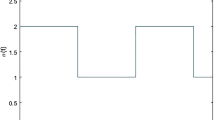Abstract
Most real world plants often operate in continuous-time case and involve time delay. These models are typically described by ordinary differential equations. However, to utilize and analyze these data, the control signals must first be discretized. In this paper, a new discretization method for obtaining an approximate sampled-data model of a nonlinear continuous-time system with time delay is proposed. The presented approach is based on the Taylor method and zero-order hold assumption, which can be used to approximate the system output and its derivatives in such a way as to obtain a local truncation error between the output of the resulting sampled-data model and true continuous-time system output. More importantly, on the basis of this discretized representation, we explicitly derive the mathematical structure of nonlinear discrete-time zero dynamics in the case of time delay. The main contribution is to analyze the stability of sampling zero dynamics for the proposed model with time delay. The ideas presented here generalize the well-known results from the linear system to nonlinear case.

Similar content being viewed by others
References
Nešić, D., Teel, A.: Perspectives in robust control. In: Sampled-Data Control of Nonlinear Systems: An Overview of Recent Results. Springer-Verlag, ch14 (2001)
Nešić, D., Teel, A.: A framework for stabilization of nonlinear sampled-data systems based on their approximate discrete-time models. IEEE Trans. Autom. Control 49(7), 1103–1122 (2004)
Yuz, J.I., Goodwin, G.C.: On sampled-data models for nonlinear systems. IEEE Trans. Autom. Control 50(10), 1447–1489 (2005)
Åström, K.J., Hagander, P., Sternby, J.: Zeros of sampled systems. Automatica 20, 31–38 (1984)
Monaco, S., Normand-Cyrot, D.: Zero dynamics sampled nonlinear systems. Syst. Control Lett. 11, 229–234 (1988)
Ishitobi, M., Nishi, M.: Zero dynamics of sampled-data models for nonlinear systems. In: Proceedings of the American Control Conference, Washington, USA, pp. 1184–1189 (2008)
Ishitobi, M., Nishi, M., Kunimatsu, S.: Stability of zero dynamics of sampled-data nonlinear systems. In: Proceedings of the 17th IFAC World Congress, Seoul, Korea, pp. 5969–5973 (2008)
Åström, K.J., Wittenmark, B.: Adaptive Control. Addison-Wesley, Reading, MA (1989)
Åström, K.J., Wittenmark, B.: Computer Controlled Systems: Theory and Design, 2nd edn. Prentice-Hall, Englewood Cliffs, NJ (1990)
Kazantzis, N., Chong, K.T., Park, J.H., Parlos, A.G.: Control-relevant discretization of nonlinear systems with time-delay using taylor-lie series. J. Dyn. Syst. Meas. Control 127, 153–159 (2005)
Franklin, G., Workman, M.: Digital Control of Dynamic Systems. Addison-Wesley Longman Publishing, Boston (1997)
Vaccaro, R.J.: Digital Control. McGraw-Hill, New York (1995)
Isidori, A.: Nonlinear Control Systems: An Introduction. Springer, Berlin (1995)
Khalil, H.: Nonlinear Systems. Prentice-Hall, Englewood Cliffs, NJ (2002)
Hara, S., Kondo, R., Katori, H.: Properties of zeros in digital control systems with computational time delay. Int. J. Control 49, 493–511 (1989)
Butcher, J.: The Numerical Analysis of Ordinary Differential Equations. Wiley, New York (1987)
Zhang, F.: Matrix Theory: Basic Results and Techniques. Springer, New York (1999)
Acknowledgments
The authors gratefully acknowledge the financial support of the National Basic Research Program of China (“973” Grant No. 2013CB328903), the National Natural Science Foundation of China under Grant No. 60574003, Natural Science Foundation Project of CQ CSTC under Project No. cstc2012jjA40026, the Joint Funds of the Natural Science Foundation of Guizhou (Gramt No, 2014GZ80427) and CDJXS12170006 Supported by the Fundamental Research Funds for the Central Universities. The authors also gratefully acknowledge the helpful comments and suggestions of the viewers, which have improved the presentation.
Author information
Authors and Affiliations
Corresponding author
Appendix: Proof of Lemma 2
Appendix: Proof of Lemma 2
Consider the \(n\)th-order integrator
with an input \(u(t)\) and an output \(y(t)\). In the following, we discuss the sampled-data model obtained from the linear transfer function (60) with a time delay. First, we define the state variables such as \(x_{1}(t)=y(t), x_{2}(t)=\dot{y}(t), \ldots , x_{n}(t)=y^{n-1}(t)\).
Applying a higher-order Taylor expansion such as
Thus, the matrix state equation is expressed as
where \(x_{k}=[x_{1}(k), x_{2}(k), \ldots , x_{n}(k)]^{T}\) and \({\tilde{u}}_{k}=u(t-D)\).
The zeros of the sampled-data model above are determined by \(y(k+1)=y(k)=0\) in (62) as follows:
where \(\overline{x}_{k}=[x_{2}(k), \ldots , x_{n}(k)]^{T}\).
Using \(z\)-transform to (63), it leads to
and then we see that the zeros are solution of \(|\phi _{n}(z)|=0\), where
Here, the matrix \(S\) is defined as
Adding the final \(n+1\)th column to the \(n\)th column in (65), Multiplying it by the matrix \(S\) from the right hand side yields
Hence, we have
because \(|S|=1\). Further, recall here that, \(|\overline{ \varPhi }_{n}(z)|\) is a monic polynomial with order \(n\) from the definition.
When the transfer function (60) is discretized by a ZOH in the case of time delay, the pulse transfer function \(H_\mathrm{D}(z)\) is given by
where \(B_{n}(z,D)\) is a monic polynomial with the order \(n\) [15]. Therefore, we have obtained
Also, we consider the sampled-data model for the \(n\)th-order integrator given by (62), and the state space similarity transformation \(z=Tx\), where the nonsingular matrix \(T\) is given by
where
Then, the new state space representation is given by the following matrices
where
and
These state space matrices give the normal form that appears in (9).
To prove (10), we first note that
Computing the determinant of the matrices on both side of the equation and using determinant formula about the matrix inversion [17], we have that
where, from definition of \(G_{22}\) in (73), we finally have that
Rights and permissions
About this article
Cite this article
Zeng, C., Liang, S. & Li, H. Asymptotic properties of zero dynamics for nonlinear discretized systems with time delay via Taylor method. Nonlinear Dyn 79, 1481–1493 (2015). https://doi.org/10.1007/s11071-014-1755-9
Received:
Accepted:
Published:
Issue Date:
DOI: https://doi.org/10.1007/s11071-014-1755-9




